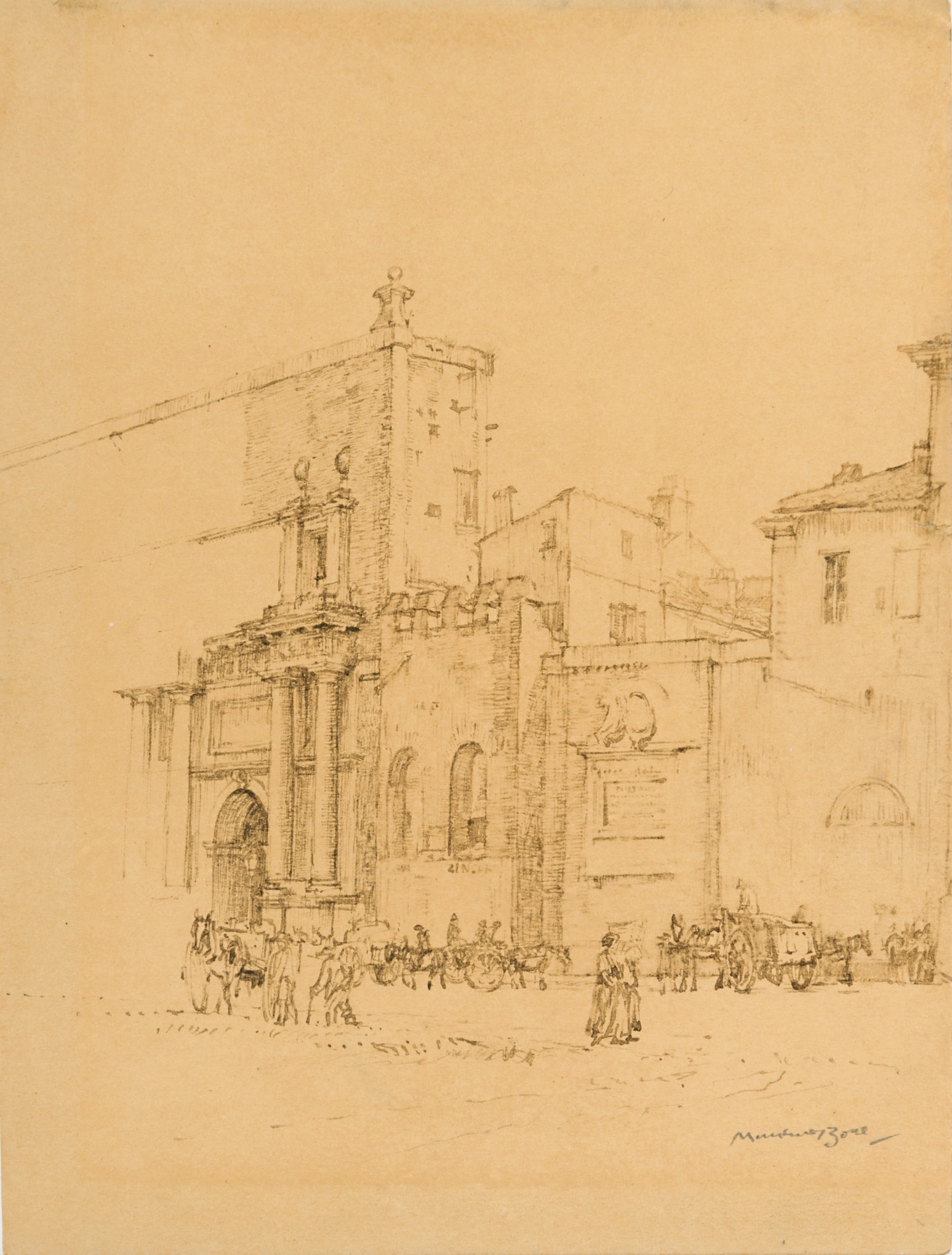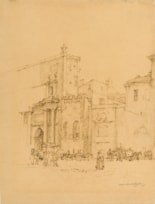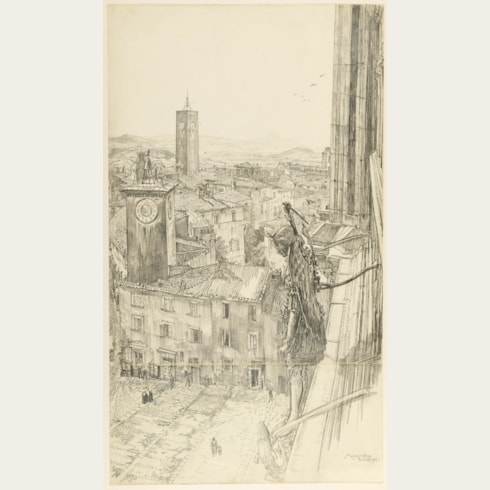Muirhead BONE
(Glasgow 1876 - Oxford 1953)
The Porta del Popolo, Rome
Sold
Pen and brown ink on buff paper.
Signed Muirhead Bone at the lower right.
222 x 170 mm. (8 3/4 x 6 5/8 in.)
Signed Muirhead Bone at the lower right.
222 x 170 mm. (8 3/4 x 6 5/8 in.)
One of the first trips that Muirhead Bone made outside Britain was a long stay of two years - from October 1910 to October 1912 – in central and northern Italy, accompanied by his wife Gertrude and their children. After spending several weeks in Florence, the Bone family settled in Rome in the early months of 1911, and from October 1911 lived in a flat overlooking the Piazza del Popolo. During his time in Italy Bone produced thirty-two copper plates and numerous fine drawings, several of which were sent from Italy to London and Glasgow to be sold by his dealers. A number of Bone’s drawings of Italy were exhibited at the Colnaghi and Obach gallery in London in 1914, to very positive reviews.
The present sheet depicts part of the outer façade of the city gate known as the Porta del Popolo, a section part of the Aurelian Walls encircling the city of Rome. The gate was the main entrance to Rome from the Via Flaminia and the north, and was used by most travellers arriving into the city for the first time. Built by Pope Sixtus IV for the Jubilee year of 1475, the Porta del Popolo was remodelled in the 16th century under Pope Pius IV. The Pope had asked Michelangelo to design the new outer façade of the Porta, but the elderly artist passed the commission on to the architect Nanni di Baccio Bigio, who completed the work between 1562 and 1565. Bone here depicts just the extreme right-hand side of the Porta del Popolo, viewed from the Piazzale Flaminio just outside the gate, and showing further buildings to the right.
Bone drew another view of the other side of the Porta del Popolo, together with the Piazza del Popolo and the church of Santa Maria del Popolo, seen from a terrace on the Pincian Hill, in a pencil drawing now in the National Gallery of Art in Washington, D.C.
Writing after the artist’s death in 1953, Sir Kenneth Clark recalled Muirhead Bone’s ‘almost miraculous skill. Like all other artists drawing in public places he was bothered by the crowds of curious onlookers who pressed around him while he worked. He therefore adopted the device of covering his sheet with pieces of paper so that he drew only along a narrow horizontal strip. The strip moved as the drawing proceeded. Considering the quantity of detail which most of his drawings contain, it is almost incredible that he was able to maintain the general construction and unity of tone by this method. British artists, whatever their merits, are not usually remarkable for technical skill and Bone must be the only one who can be compared with the great Italians, Piranesi or Bibiena.’
The present sheet depicts part of the outer façade of the city gate known as the Porta del Popolo, a section part of the Aurelian Walls encircling the city of Rome. The gate was the main entrance to Rome from the Via Flaminia and the north, and was used by most travellers arriving into the city for the first time. Built by Pope Sixtus IV for the Jubilee year of 1475, the Porta del Popolo was remodelled in the 16th century under Pope Pius IV. The Pope had asked Michelangelo to design the new outer façade of the Porta, but the elderly artist passed the commission on to the architect Nanni di Baccio Bigio, who completed the work between 1562 and 1565. Bone here depicts just the extreme right-hand side of the Porta del Popolo, viewed from the Piazzale Flaminio just outside the gate, and showing further buildings to the right.
Bone drew another view of the other side of the Porta del Popolo, together with the Piazza del Popolo and the church of Santa Maria del Popolo, seen from a terrace on the Pincian Hill, in a pencil drawing now in the National Gallery of Art in Washington, D.C.
Writing after the artist’s death in 1953, Sir Kenneth Clark recalled Muirhead Bone’s ‘almost miraculous skill. Like all other artists drawing in public places he was bothered by the crowds of curious onlookers who pressed around him while he worked. He therefore adopted the device of covering his sheet with pieces of paper so that he drew only along a narrow horizontal strip. The strip moved as the drawing proceeded. Considering the quantity of detail which most of his drawings contain, it is almost incredible that he was able to maintain the general construction and unity of tone by this method. British artists, whatever their merits, are not usually remarkable for technical skill and Bone must be the only one who can be compared with the great Italians, Piranesi or Bibiena.’
Born in a suburb of Glasgow, Muirhead Bone was initially trained as an architect, but abandoned this career is favour of working as a draughtsman and printmaker. His first etchings date from 1898, and, as the collector and scholar Campbell Dodgson has noted, ‘Like several etchers who have distinguished themselves in after life by a style of marked originality, he found out the technique for himself, or at least without a definite course of study under any teacher or in any school of engraving.’ Bone’s early etchings were of scenes in and around Glasgow and the banks of the River Clyde, and a handful of his prints were exhibited at the Royal Academy and the New English Art Club in London. In the winter of 1901 the artist settled in London, where a few months later an exhibition of his prints was held at the Carfax Gallery. From 1904 his prints were published by Obach and Co., and the same year Bone became a founding member and honorary secretary of the Society of Twelve, established as an exhibition society devoted to original prints and drawings. (Other founder members included William Strang, David Young Cameron, George Clausen, William Nicholson, Augustus John and William Rothenstein.) Bone participated in several of the society’s exhibitions, which were held between 1904 and 1915. Among his most significant works of the first decade of the 20th century were the drypoints of The Demolition of St. James’s Hall of 1906 and 1907 and The Great Gantry, Charing Cross Station of 1906, and a large pencil drawing of The British Museum Reading Room of 1907. Each of these works, characterized by a novel viewpoint of a well-known building and an abiding attention to detail, were prefaced by numerous studies and drawings. As his grandson and biographer has noted of Bone, ‘his method of working seems to have been to record as much as he could in a detailed, on-the-spot drawing and to work this up over several months to a finished print or drawing, which would be the centrepiece of his submission to the next exhibition of the Society of Twelve.’
By 1909 Dodgson had published a catalogue raisonné of Bone’s oeuvre as a printmaker, which at that point amounted to 225 works. (A later unpublished typescript by Dodgson listed a further 252 prints, dating up to 1939.) During the First World War Bone was appointed Britain’s first Official War Artist. From 1916 onwards he spent much of the next two years on the Western Front, working at a furious pace and producing numerous drawings and watercolours of the military campaigns and its effect on the surrounding countryside, intended for both journalistic and propagandic purposes. Many of his drawings were published as The Western Front: Drawings by Muirhead Bone, which appeared in monthly instalments throughout 1916 and 1917, eventually amounting to some 30,000 printed copies all told. In 1918 Bone published The Western Front; a series of one hundred drawings of military life.
After the First World War Bone found his stature in England secure, and enjoyed considerable commercial and critical success over the next thirty-five years. He was much honoured, and served as a trustee of the Imperial War Museum, the National Gallery and the Tate Gallery, although he declined to be considered for membership in the Royal Academy. He travelled widely within Britain and throughout Europe, especially Spain, and made drawings and etchings of the places he visited. After the Wall Street Crash of 1929 the market for fine prints declined considerably in the 1930s, and Bone turned more towards marketing and exhibiting his drawings, usually at Colnaghi’s, and taking on illustration commissions for newspapers and magazines. During the Second World War Bone served on the War Artists’ Advisory Committee of the Ministry of Information, chaired by Kenneth Clark, and produced a number of fine, large-scale drawings of London during the Blitz and scenes of the Home front.
Bone’s drawings were as much admired as his etchings, and his larger and more ambitious drawings were often sold for between £20 and £50 apiece. Several of his drawings were reproduced in such publications as the Architectural Review, the Pall Mall Gazette, the Art Journal, the Illustrated London News and the German Die Graphischen Künste. Bone produced only a handful of oil paintings, however. As Dodgson noted, ‘he is much more at home with pencil and charcoal, ink and water-colour wash and pastel, than with the pigments and utensils of the landscape painter in oils. He is a “black and white” artist first and foremost, and one of the most gifted, varied and accomplished draughtsmen that have ever been known. Gifted with a fresh and eager interest in the forms of things, singly and in relation to others, that enables him to discover beauty of surface or shape or proportion in objects that the less curious eye ignores as dull and ugly…gifted, above all with a most astonishing eyesight, keen, searching and tireless, and with equally unfailing sureness of hand.’
As Campbell Dodgson has further written, ‘Muirhead was brought up to be an architect, and he owes to that apprenticeship the thorough knowledge of construction, the extraordinary eye for significant detail, and the sureness of hand whether in finished or in summary drawing, which no etcher could acquire who should approach architecture merely from the outside. For him, however, drawing soon came to be of paramount interest, and he relinquished all thought of practicing architecture as a profession.’
In a letter to The Times written shortly after Bone’s death, the artist Sir William Russell Flint noted that ‘Muirhead Bone’s extraordinarily alert and sensitive eye was merely the instrument of his inner vision and uncanny perception. In his more sombre architectural subjects dignity always prevailed. His buildings seemed part of Nature, carrying ornamentation and finicky detail as a great oak carries its leaves…We have lost one of the great draughtsmen of all time.’
By 1909 Dodgson had published a catalogue raisonné of Bone’s oeuvre as a printmaker, which at that point amounted to 225 works. (A later unpublished typescript by Dodgson listed a further 252 prints, dating up to 1939.) During the First World War Bone was appointed Britain’s first Official War Artist. From 1916 onwards he spent much of the next two years on the Western Front, working at a furious pace and producing numerous drawings and watercolours of the military campaigns and its effect on the surrounding countryside, intended for both journalistic and propagandic purposes. Many of his drawings were published as The Western Front: Drawings by Muirhead Bone, which appeared in monthly instalments throughout 1916 and 1917, eventually amounting to some 30,000 printed copies all told. In 1918 Bone published The Western Front; a series of one hundred drawings of military life.
After the First World War Bone found his stature in England secure, and enjoyed considerable commercial and critical success over the next thirty-five years. He was much honoured, and served as a trustee of the Imperial War Museum, the National Gallery and the Tate Gallery, although he declined to be considered for membership in the Royal Academy. He travelled widely within Britain and throughout Europe, especially Spain, and made drawings and etchings of the places he visited. After the Wall Street Crash of 1929 the market for fine prints declined considerably in the 1930s, and Bone turned more towards marketing and exhibiting his drawings, usually at Colnaghi’s, and taking on illustration commissions for newspapers and magazines. During the Second World War Bone served on the War Artists’ Advisory Committee of the Ministry of Information, chaired by Kenneth Clark, and produced a number of fine, large-scale drawings of London during the Blitz and scenes of the Home front.
Bone’s drawings were as much admired as his etchings, and his larger and more ambitious drawings were often sold for between £20 and £50 apiece. Several of his drawings were reproduced in such publications as the Architectural Review, the Pall Mall Gazette, the Art Journal, the Illustrated London News and the German Die Graphischen Künste. Bone produced only a handful of oil paintings, however. As Dodgson noted, ‘he is much more at home with pencil and charcoal, ink and water-colour wash and pastel, than with the pigments and utensils of the landscape painter in oils. He is a “black and white” artist first and foremost, and one of the most gifted, varied and accomplished draughtsmen that have ever been known. Gifted with a fresh and eager interest in the forms of things, singly and in relation to others, that enables him to discover beauty of surface or shape or proportion in objects that the less curious eye ignores as dull and ugly…gifted, above all with a most astonishing eyesight, keen, searching and tireless, and with equally unfailing sureness of hand.’
As Campbell Dodgson has further written, ‘Muirhead was brought up to be an architect, and he owes to that apprenticeship the thorough knowledge of construction, the extraordinary eye for significant detail, and the sureness of hand whether in finished or in summary drawing, which no etcher could acquire who should approach architecture merely from the outside. For him, however, drawing soon came to be of paramount interest, and he relinquished all thought of practicing architecture as a profession.’
In a letter to The Times written shortly after Bone’s death, the artist Sir William Russell Flint noted that ‘Muirhead Bone’s extraordinarily alert and sensitive eye was merely the instrument of his inner vision and uncanny perception. In his more sombre architectural subjects dignity always prevailed. His buildings seemed part of Nature, carrying ornamentation and finicky detail as a great oak carries its leaves…We have lost one of the great draughtsmen of all time.’
Provenance
An unidentified triangular collector’s mark with the initials RSM (not in Lugt) stamped on the verso.
Exhibition
Possibly Berlin, Austellunghaus am Kurfürstendamm, Fünfundzwanigste Ausstellung der Berliner Secession: Zeichnende Künste, November-December 1912, no.78 (‘Porta del Popolo, Rom’).





